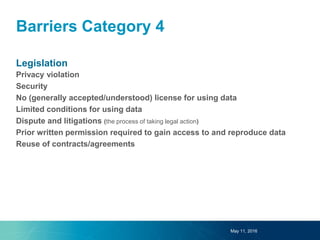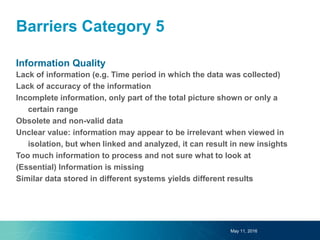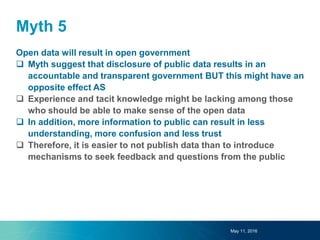Benefits, Adoption Barriers and Myths of Open Data and Open Governmnet
- 1. Benefits, Adoption Barriers and Myths of Open Data and Open Government Presenter: Fatemeh Ahmadi Zeleti E-Gov Unit Based on: M. Janssen, Y. Charalabidis & A. Zuiderwijk (2012). Benefits, Adoption Barriers and Myths of Open Data and Open Government. Information Systems Management (ISM), vol. 29, no.4, pp. 258-268 May 11, 2016
- 2. Overview Data is defined as non-privacy restricted and non- confidential data which is produced by public money and is made available without any restrictions on its usage and distribution Public bodies are the largest data creators and collectors Opening of data reinforce existing structures instead of changing them Opening data leads to two assumptions about government Readiness of public agencies for an opening process Government is to give up control May 11, 2016
- 3. Problem and the Paper Research on open data is limited No paper (by 2012) focus on analyzing the benefits and barriers of open data This paper analyzes the benefits and barriers of open data by synthesizing people’s experiences with open data May 11, 2016
- 4. The paper Open data benefits Adoption barriers of open data Myths of open data
- 5. Approach Analyzing the literature Literature was used as a background for organizing a group session Session with 9 participants was held in June 2011 Findings from the session were refined based on the interviews with 14 key persons The interviews were aimed at better understanding the nature of the benefits and barriers and were used to determine the myths of open data. May 11, 2016
- 6. Potential Benefits The benefits are clustered into 3 groups: 1) Political and social (public value: transparency and accountability)* 2) Economic 3) Operational and technical * Political and social benefits are viewed as the most important category and are the overarching arguments for stimulating open data May 11, 2016
- 7. Potential Benefits – Category 1 Political and social More transparency Democratic accountability More participation and self-empowerment of citizens (users) Creation of trust in government Public engagement Scrutinization of data Equal access to data New governmental services for citizens Improvement of citizen services Improvement of citizen satisfaction Improvement of policy-making processes More visibility for the data provider Stimulation of knowledge developments Creation of new insights in the public sector New (innovative) social services May 11, 2016
- 8. Economic Economic growth and stimulation of competitiveness Stimulation of innovation Contribution toward the improvement of processes, products and/or services Development of new products and services Use of the wisdom of the crowds: tapping into the intelligence of the collective Creation of a new sector adding value to the economy Availability of information for investors and companies Potential Benefits- Category 2 May 11, 2016
- 9. Operational and technical The ability to reuse data / not having to collect the same data again and counteracting unnecessary duplication and associated costs (also by other public institutions) Optimization of administrative processes Improvement of public policies Access to external problem solving capacity Fair decision-making by enabling comparison Easier access to data and discovery of data Creation of new data based on combining data External quality checks of data (validation) Sustainability of data (no data loss) The ability to merge, integrate and mesh public and private data Potential Benefits- Category 3 May 11, 2016
- 10. Some Insights from the Interviewees “effective use of public sector data is vital to the growth of our knowledge economy” “if data is used for policy-making a high level of confidence in the data and in the veracity of the interpretation is given. Therefore policymakers should be prepared to share their data” Most of the interviewees expect that open data can strengthen accountability, build trust and improve citizen satisfaction One of the main benefits of opening a system is the ability to tap into the collective intelligence of the public. The key idea is that under the right circumstances, groups can generate better alternatives and make better decisions than even the smartest people can do on their own May 11, 2016
- 11. Barriers Barriers are identified and categorized into the ff 6 levels: 1) Institutional level -> Data provider’s perspective 2) Task complexity of handling the data -> User’s perspective 3) Use of open data and participation in the open data process -> User’s perspective 4) Legislation -> Relevant for both providers and users 5) Information quality -> Relevant for both providers and users 6) Technical -> Relevant for both providers and users May 11, 2016
- 12. Barriers Category 1 Institutional Level Barriers Emphasis of barriers and neglect of opportunities Unclear trade-off between public values (transparency vs. privacy values) Risk-averse culture (no entrepreneurship culture) No uniform policy for publicizing data Making public only non-value-adding data No resources with which to publicize data (especially small agencies) Revenue system is based on creating income from data Fostering local organizations’ interests at the expense of citizen interests No process for dealing with user input (no adequate feedback system) Debatable quality of user input May 11, 2016
- 13. Barriers Category 2 Task Complexity Lack of ability to discover the appropriate data No access to the original data (only processed data) No explanation of the meaning of data No information about the quality of the open data (see category “Information Quality”) Duplication of data, data available in various forms or before/after processing resulting in discussions about what the source is Difficulty in searching and browsing due to no index or other means to ensure easy search for finding the right data Even if data can be found, users might not be aware of its potential uses Data formats and data sets are too complex to handle and use easily No tooling support or help desk Focus is on making use of single data sets, whereas the real value might come from combining various data sets Contradicting outcomes based on the use of the same data (right? wrong?) Invalid conclusions May 11, 2016
- 14. Barriers Category 3 Use and participation No incentives for the users Public organizations do not react to user input Frustration at there being too many data initiatives No time to delve into the details or no time at all Having to pay a fee for the data Registration required before being able to download the data Unexpected escalated costs No time to make use of the open data Lack of knowledge to make use of or to make sense of data Lack of the necessary capability to use the information No statistical knowledge or understanding of the potential and limitations of statistics Thread of lawsuits or other violations May 11, 2016
- 15. Barriers Category 4 Legislation Privacy violation Security No (generally accepted/understood) license for using data Limited conditions for using data Dispute and litigations (the process of taking legal action) Prior written permission required to gain access to and reproduce data Reuse of contracts/agreements May 11, 2016
- 16. Barriers Category 5 Information Quality Lack of information (e.g. Time period in which the data was collected) Lack of accuracy of the information Incomplete information, only part of the total picture shown or only a certain range Obsolete and non-valid data Unclear value: information may appear to be irrelevant when viewed in isolation, but when linked and analyzed, it can result in new insights Too much information to process and not sure what to look at (Essential) Information is missing Similar data stored in different systems yields different results May 11, 2016
- 17. Barriers Category 6 Technical Data must be in a well-defined format that is easily accessible: while the format of data is arbitrary, the format of data definitions needs to be rigorously defined No understanding of standards (country open data standards (e.g. handbook) is not well documented) No central portal or internationally/nationally accepted architecture No support for making data available Lack of understanding of metadata standards No standard software for processing open data/ different approach exist Legacy systems that complicate the publicizing of data May 11, 2016
- 18. Some Insights from the Interviewees “only data that is relatively safe is publicized and dropped in the large pile … some of them even hope that the data will not be discovered in this pile … there are no mechanisms for gaining any feedback about its use” “The reinforcement of the existing structure was strengthened due to the current budget cuts. Reinforcement also originate from the lack of systematic analysis about which type of data should be allowed to be publicized and what users expect from open data. This provides arguments for not publishing data.” “Use is limited to the happy few, those who are educated and have time to explore new business opportunities” May 11, 2016
- 19. What is Myth and Why to Formulate it What: A myth is a traditional or legendary story without a determinable basis of fact or evidence. The essence of a myth is that its existence is fictional or unproven. Why: Oftentimes a conceptually simplistic look at open data is taken (by different stakeholders) May 11, 2016
- 20. The paradox Myths play an important role in policy-making – The one sided advantage “Our politicians are not aware of what is necessary. First they push to publicize data, next, they complain about the transparency and ask us to react to the questions asked … transparency seems to be desirable only for others rather than for their own activities” May 11, 2016
- 21. The Five Myths of Open Data Based on the interviewees the authors identify five myths which proved not to be supported by evidence but were often found at the heart of policy-making 1) The publicizing of data will automatically yield benefits 2) All information should be unrestrictedly publicized 3) It is a matter of simply publishing public data 4) Every constituent can make use of open data 5) Open data will result in open government May 11, 2016
- 22. Myth 1 The publicizing of data will automatically yield benefits Open data on its own has little value; the value is created by its use. Therefore, supporting use should not be viewed as secondary to publicizing data The publicizing of data needs to be accompanied by an infrastructure which is able to handle the data in an easy-to-use way to lower the user threshold It cannot be expected that the public has the same amount of knowledge and capabilities as researchers do. Lowering the knowledge level required for use is key to large-scale dissemination The creation of a huge pool of information might result in difficulty in finding the right information. The more data there is, the more difficult it is to analyze and draw meaningful conclusions May 11, 2016
- 23. Myth 2 All information should be unrestrictedly publicized Data that can be traced back to the individual may not be publicized due to privacy legislation Limited resources for publishing, especially if the publishing of open data does not bring benefits, can be another reason for not opening data to the public The complexity of data structures and difficulty to understand the data might make it less attractive to publicize it Law might prevent the publication of certain data Data sets receive income for some public organizations and they can ask for fee (Fee-base business model) The arbitrary opening of some data might result into a biased picture of the situation May 11, 2016
- 24. Myth 3 It is a matter of simply publishing public data This myth challenges that data can be made available without additional activities Not true myth -> Meta-data (publisher, authors, timeliness) is necessary to overcome barriers like searching, interpretation and so on Governments that publish data sets face substantial criticism such as poor usability, lack of data feedback and improvement mechanisms, and inadequate meta-data => Standardization of methods and the development of robust meta-data can increase data access **Data users want answers to their questions, services and other added value that can be created from open data. Processing open data is simply the hoop they have to jump through to gain answers to their questions** May 11, 2016
- 25. Myth 4 Every constituent can make use of open data This myth assumes that open data users have the resources, expertise and capabilities to make use of the data Working with data requires capabilities (statistical techniques, understanding underlying data and data relationships) Only people with required capabilities is able to make sense out of data Data visualization and guide on how to use data can help non- experienced users Automating the annotation and classification of data can help in simplifying searches , analyze relationship and etc. May 11, 2016
- 26. Myth 5 Open data will result in open government Myth suggest that disclosure of public data results in an accountable and transparent government BUT this might have an opposite effect AS Experience and tacit knowledge might be lacking among those who should be able to make sense of the open data In addition, more information to public can result in less understanding, more confusion and less trust Therefore, it is easier to not publish data than to introduce mechanisms to seek feedback and questions from the public May 11, 2016
- 27. Conclusion There are benefits and barriers in opening data and using data More research into the specific benefits, barriers and value of open data is necessary. The long list of benefits presented in this paper can be used in determining the benefits on a case by case basis Data are said to be publicized in name but they are still private in practice Data providers must provide easy-to- understand data rather than publicizing data Arguments in favor of open data are based on a rather simplistic and idealized view Being able to use data and find patterns and trends remains a significant challenge therefore there is a need for having good structures and support for handling data The myths are: Convincing data providers to open their data for public to use While the user view is largely ignored and that use of data is not easy May 11, 2016
- 28. Q&A



























